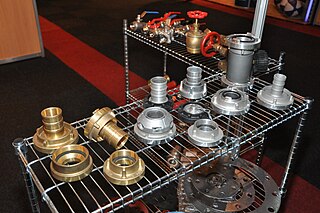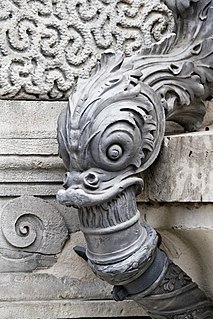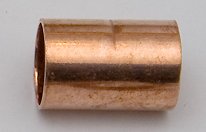What Thread Is A Garden Hose
Garden hose
Last updated
A garden hose, hosepipe, or simply hose is a flexible tube used to convey water. There are a number of common attachments available for the end of the hose, such as sprayers and sprinklers (which are used to concentrate water at one point or to spread it over a large area). Hoses are usually attached to a hose spigot or tap.
- Terminology
- Description
- Use
- Porous or perforated soaker hoses
- Expandable hoses
- Standards and connectors
- Quick connectors
- Health risks from aerosols
- Gallery
- See also
- References
- External links
Terminology
The alternative term "hosepipe" is a chiefly British, South African, and southern US usage; "hose" or "garden hose" is the predominant term in other English-speaking areas. The term "hose" is also used for other types of flexible, water-carrying tubes such as those used by fire departments.
Description
Garden hoses are typically made of extruded synthetic rubber or soft plastic, often reinforced with an internal web of fibers. As a result of these materials, garden hoses are flexible and their smooth exterior facilitates pulling them past trees, posts and other obstacles. Garden hoses are also generally tough enough to survive occasional scraping on rocks and being stepped on, without damage or leaking.
Each male end of a typical garden hose can mate with the female connector on another, which allows multiple garden hoses to be linked end-to-end to increase their overall length. Small rubber or plastic washers (often confusingly called "hose washers") are used in female ends to prevent leakage, because the threads are not tapered and are not used to create a seal.
Most garden hoses are not rated for use with hot water; even leaving certain hoses in the sun while pressurized can cause them to burst.
Hoses used to carry potable water are typically made of NSF International-listed polymers tested and shown not to leach harmful materials into the drinking water, such as the plasticizers (phthalates) used in polyvinyl chloride (PVC, or vinyl) hoses.
Use
As implied by the name, garden hoses are commonly used to transport water for gardening, lawn care, and other landscaping purposes. They are also used for outdoor cleaning of items such as vehicles, equipment, building exteriors, and animals. NSF-approved hoses may be used for connecting drinkable water to recreational vehicles and trailers.
Whenever a flexible hose is connected to a drinkable water supply, the spigot or tap should be fitted with an approved backflow prevention device, to prevent contaminated water from being siphoned back, in the event of a pressure drop. Many water suppliers require this, and plumbing code may legally require permanently installed backflow preventers.
Porous or perforated soaker hoses
Special hoses designed to leak throughout their length are sometimes used to gently distribute water on a lawn or garden. These hoses have either many small holes drilled or punched in them, or are made of a porous material, such as sintered rubber particles. These "soaker hoses" [1] are a simple, low-cost, substitute for a drip irrigation system.
Expandable hoses
These differ from traditional hoses in that the inner membrane expands when filled with water, much like a balloon. An outer cover protects the delicate expandable membrane from punctures. Such hoses "grow" when pressurized, and shrink back down when the pressure is released, allowing for easier storage.
Standards and connectors

Garden hoses connect using a male/female thread connection. The technical term for this arrangement is a "hose union". Spigots or sillcocks have male hose connectors only, and the mating end of a hose has a captive nut which fits the threads there.
The thread standard for garden hose connectors in the United States, its territories, and Canada is known colloquially as "garden hose thread" (GHT), but its official designation is NH ("National Hose"):
- 3 ⁄ 4 -11.5NH designates full form threads as produced by cutting material such as the brass spigot outlet or hose male or female end fitting found on more expensive hoses.
- 3 ⁄ 4 -11.5NHR designates thin-walled couplers produced by rolling thin material, usually brass, typically found on less expensive hoses.
- 3 ⁄ 4 -14NPSH designates female hose ends that mate a hose to a tapered pipe thread without a spigot.
The US standard was defined by NFPA 1963, "Standard for Fire Hose Connections", [2] then later by ANSI-ASME B1.20.7, [3] which specifies 1+ 1 ⁄ 16 inches (27 mm) diameter straight (non-tapered) thread with a pitch of 11.5 threads per inch (TPI). The female thread is abbreviated FHT (for "female hose thread"), and the male part is abbreviated MHT (for "male hose thread"). This fitting is used with 1 ⁄ 2 -inch, 5 ⁄ 8 -inch, and 3 ⁄ 4 -inch hoses. [4] [5]
In other countries, a British Standard Pipe (BSP) thread is used, which is 3 ⁄ 4 inch (19 mm) and 14TPI (male part outside diameter is 26.441 mm or 1.04 in). The GHT and BSP standards are not compatible, and attempting to connect a GHT hose to a BSP fitting, or vice versa, will damage the threads.
Various adaptors made of metal or plastic are available to interconnect GHT, BSP, NPT, hose barb, and quick connect fittings.
Quick connectors
In the 1980s, the use of quick-connector systems became increasingly popular. These are fittings that attach to the hose and or screw into common hose connectors and equipment, allowing hoses and accessories to be easily connected together using a snap-fit type system. The first plastic connector was invented in the UK by Hozelock in 1959 [6] and the style has now become the de facto standard throughout Europe and the wider world, compatible with and imitated by many other manufacturers. Some connectors include an internal valve that is only opened by connecting the fitting, so that disconnecting a hose using this adaptor causes the water flow to stop. This greatly eases common tasks by allowing specialised sprayers to be interchanged without requiring adapters or spigot changes.
Health risks from aerosols
In 2014, it was reported that use of common garden hoses in combination with spray nozzles may generate aerosols containing droplets smaller than 10 μm, which can be inhaled by nearby people. Water stagnating in a hose between uses, especially when warmed by the sun, can host the growth and interaction of Legionella and free-living amoebae (FLA) as biofilms on the inner surface of the hose. Clinical cases of Legionnaires' disease or Pontiac fever have been found to be associated with inhalation of garden hose aerosols containing Legionella bacteria. The report provided measured microbial densities resulting from controlled hose conditions in order to quantify the human health risks. The densities of Legionella spp. identified in two types of hoses were found to be similar to those reported during legionellosis outbreaks from other causes. It was proposed that the risk could be mitigated by draining hoses after use. [7]
Gallery
-

Garden hose in use (Germany)
-
Closeup of a garden hose shows the crisscrossed fiber reinforcements
-

Gardena quick-connect hose fittings
-

Hose cart and some quick-connect fittings
-
This greenhouse is equipped with a hose suspended on pulleys
-
.jpg)
Special expandable hose can be stretched to reach farther
See also
- Drip irrigation
- Fire hose
- Hose coupling
- Outdoor water-use restriction, or "hosepipe ban"
Related Research Articles

Plumbing is any system that conveys fluids for a wide range of applications. Plumbing uses pipes, valves, plumbing fixtures, tanks, and other apparatuses to convey fluids. Heating and cooling (HVAC), waste removal, and potable water delivery are among the most common uses for plumbing, but it is not limited to these applications. The word derives from the Latin for lead, plumbum, as the first effective pipes used in the Roman era were lead pipes.

A tap is a valve controlling the release of a liquid or gas.

American National Standard Pipe Thread standards, often called national pipe thread standards for short, are U.S. national technical standards for screw threads used on threaded pipes and pipe fittings. They include both tapered and straight thread series for various purposes, including rigidity, pressure-tight sealing, or both. The types are named with a symbol and a full name. Examples of the symbols include NPT, NPS, NPTF, NPSC.

A hose is a flexible hollow tube designed to carry fluids from one location to another. Hoses are also sometimes called pipes, or more generally tubing. The shape of a hose is usually cylindrical.

In electrical and mechanical trades and manufacturing, each half of a pair of mating connectors or fasteners is conventionally assigned the designation male or female. The female connector is generally a receptacle that receives and holds the male connector. Sometimes the terms plug and socket or jack are used, particularly in reference to electrical connectors. In some cases, the pins on the connector may have the opposite nominal gender to the mounted connector, such as the RCA connector.

A screw thread, often shortened to thread, is a helical structure used to convert between rotational and linear movement or force. A screw thread is a ridge wrapped around a cylinder or cone in the form of a helix, with the former being called a straight thread and the latter called a tapered thread. A screw thread is the essential feature of the screw as a simple machine and also as a threaded fastener.
This is a glossary of firefighting equipment.

In plumbing and piping, a nipple is a fitting, consisting of a short piece of pipe, usually provided with a male pipe thread at each end, for connecting two other fittings.

A hose coupling is a connector on the end of a hose to connect it with another hose or with a tap or a hose appliance, such as an irrigation sprinkler. It is usually made of steel, brass, stainless steel, aluminium or plastic.

A pipe is a tubular section or hollow cylinder, usually but not necessarily of circular cross-section, used mainly to convey substances which can flow — liquids and gases (fluids), slurries, powders and masses of small solids. It can also be used for structural applications; hollow pipe is far stiffer per unit weight than solid members.
British Standard Pipe (BSP) is a set of technical standards for screw threads that has been adopted internationally for interconnecting and sealing pipes and fittings by mating an external (male) thread with an internal (female) thread. It has been adopted as standard in plumbing and pipe fitting, except in North America, where NPT and related threads are used.

A threaded pipe is a pipe with screw-threaded ends for assembly.

A coupling is a very short length of pipe or tube, with a socket at one or both ends that allows two pipes or tubes to be joined, welded (steel), brazed or soldered together.

A fitting or adapter is used in pipe systems to connect straight sections of pipe or tube, adapt to different sizes or shapes, and for other purposes such as regulating fluid flow. These fittings are used in plumbing to manipulate the conveyance of water, gas, or liquid waste in domestic or commercial environments, within a system of pipes or tubes.

Ground glass joints are used in laboratories to quickly and easily fit leak-tight apparatus together from interchangeable commonly available parts. For example, a round bottom flask, Liebig condenser, and oil bubbler with ground glass joints may be rapidly fitted together to reflux a reaction mixture. This is a large improvement compared with older methods of custom-made glassware, which was time-consuming and expensive, or the use of less chemical resistant and heat resistant corks or rubber bungs and glass tubes as joints, which took time to prepare as well.
The Luer taper is a standardized system of small-scale fluid fittings used for making leak-free connections between a male-taper fitting and its mating female part on medical and laboratory instruments, including hypodermic syringe tips and needles or stopcocks and needles. Currently ISO 80369 governs the Luer standards and testing methods.

Flexible suction hose, not to be confused with hard suction hose in U.S., is a specific type of fire hose used in drafting operations, when a fire engine uses a vacuum to draw water from a portable water tank, pool, or other static water source. It is built to withstand vacuum, rather than pressure, abrasion, and heat. Conversely, hard suction is capable of withstanding up to 200 PSIG, as well as vacuum. In the United States, it is standard equipment according to the National Fire Protection Association standards for fire engines. It is used in both structural and wildland firefighting throughout the world, and is made in various diameters and connection types.

A cam and groove coupling, also called a camlock fitting, is a form of hose coupling. This kind of coupling is popular because it is a simple and reliable means of connecting and disconnecting hoses quickly and without tools.
Despite fire hose and hydrant coupler standardization efforts that are at least 144 years old, there remain significant areas in Canada, the United States, and Mexico that use fire hose and hydrant threads and other couplings that are incompatible with those used by neighboring fire departments. This is notable because the first fire hydrant was invented by Manhattan fire fighter George Smith in 1817, making these devices 200 years old.

A scuba cylinder valve or pillar valve is a high pressure manually operated screw-down shut off valve fitted to the neck of a scuba cylinder to control breathing gas flow to and from the pressure vessel and to provide a connection with the scuba regulator or filling whip. Cylinder valves are usually machined from brass and finished by a protective and decorative layer of chrome plating. A metal or plastic dip tube or valve snorkel screwed into the bottom of the valve extends into the cylinder to reduce the risk of liquid or particulate contaminants in the cylinder getting into the gas passages when the cylinder is inverted, and blocking or jamming the regulator.
References
- ↑ Dave's Garden. Definition of soaker hose.
- ↑ "NH=National Hose". Ring & Plug Thread Gauges . Retrieved 26 August 2017.
- ↑ ASME B1.20.7-1991. "Hose Coupling Screw Threads (Inch)" . Retrieved 26 August 2017.
- ↑ Bill Lauer (1 January 2004). AWWA Water Operator Field Guide. American Water Works Association. pp.209–. ISBN 978-1-58321-315-5.
- ↑ Rolf Ekenes (19 January 2010). Southern Marine Engineering Desk Reference. Xlibris Corporation. pp.134–. ISBN 978-1-4691-1637-2.
- ↑ https://www.hozelock.com/about-us/
- ↑ Thomas, Jacqueline M.; Thomas, Torsten; Stuetz, Richard M.; Ashbolt, Nicholas J. (2014). "Your Garden Hose: A Potential Health Risk Due to Legionella spp. Growth Facilitated by Free-Living Amoebae". Environmental Science & Technology. 48 (17): 10456–10464. Bibcode:2014EnST...4810456T. doi:10.1021/es502652n. ISSN 0013-936X. PMID 25075763.
External links
This page is based on this Wikipedia article
Text is available under the CC BY-SA 4.0 license; additional terms may apply.
Images, videos and audio are available under their respective licenses.
What Thread Is A Garden Hose
Source: https://WikiMili.com/en/Garden_hose
Posted by: arellanoexproul.blogspot.com



0 Response to "What Thread Is A Garden Hose"
Post a Comment